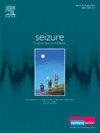发展性和癫痫性脑病伴睡眠尖波激活(D/EE-SWAS):来自50名儿童队列的临床和治疗见解
IF 2.8
3区 医学
Q2 CLINICAL NEUROLOGY
引用次数: 0
摘要
发育性和癫痫性脑病伴睡眠尖波激活(D/EE-SWAS)是一种罕见且复杂的儿童癫痫综合征,其特征是认知和/或行为退化,以及在慢波睡眠期间几乎连续的尖波放电。D/EE-SWAS包括一系列具有不同病因和结果的脑病。目的评估50例D/EE-SWAS患儿的病因、临床病程和治疗反应,重点研究潜在病因如何影响神经心理预后。方法回顾性分析本中心2005年至2023年间诊断为D/EE-SWAS的50例患儿。将患者分为三种病因:自限性局灶性癫痫(SeLFE, n=19)、脑结构异常(n=18)和遗传原因(n=7)。评估脑电图特征、认知和行为改变以及治疗反应。结果皮质激素(80.9%)、氯巴唑(55.8%)、左乙拉西坦(54.1%)、磺胺硫胺(52.9%)是最有效的治疗药物。SeLFE患者的SWAS持续时间较短,预后较好,而结构性病因患者的出院时间较长,反应较差。所有患者均表现出认知和行为倒退,其严重程度因病因而异。结论sd /EE-SWAS是一种严重程度和预后随病因而变化的谱系障碍。早期识别和有针对性的治疗,特别是对患有self - fe的儿童,对于减轻神经认知能力下降至关重要。这项大型单中心队列研究为D/EE-SWAS的治疗挑战和结果变异性提供了新的见解。本文章由计算机程序翻译,如有差异,请以英文原文为准。
Developmental and epileptic encephalopathy with spike-wave activation in sleep (D/EE-SWAS): Clinical and treatment insights from a cohort of 50 children
Background
Developmental and Epileptic Encephalopathy with Spike-Wave Activation in Sleep (D/EE-SWAS) is a rare and complex pediatric epilepsy syndrome characterized by cognitive and/or behavioral regression and nearly continuous spike-wave discharges during slow-wave sleep. D/EE-SWAS encompasses a spectrum of encephalopathies with heterogeneous etiologies and outcomes.
Objective
To assess etiology, clinical course, and treatment response in 50 children with D/EE-SWAS, with a focus on how underlying causes influence neuropsychological outcomes.
Methods
We retrospectively analyzed 50 children diagnosed with D/EE-SWAS at our center between 2005 and 2023. Patients were grouped into three etiological categories: self-limited focal epilepsies (SeLFE, n=19), structural brain abnormalities (n=18), and genetic causes (n=7). EEG features, cognitive and behavioral changes, and treatment responses were evaluated.
Results
Corticosteroids (80.9%), clobazam (55.8%), levetiracetam (54.1%), and sulthiame (52.9%) were the most effective treatments. SeLFE patients experienced shorter SWAS duration and better outcomes, while those with structural etiologies had more prolonged discharges and poorer responses. All patients showed cognitive and behavioral regression, with severity modulated by etiology.
Conclusion
D/EE-SWAS is a spectrum disorder with variable severity and prognosis depending on etiology. Early recognition and tailored treatment, especially in children with SeLFE, are essential to mitigate neurocognitive decline. This large single-center cohort provides new insights into the therapeutic challenges and outcome variability in D/EE-SWAS.
求助全文
通过发布文献求助,成功后即可免费获取论文全文。
去求助
来源期刊

Seizure-European Journal of Epilepsy
医学-临床神经学
CiteScore
5.60
自引率
6.70%
发文量
231
审稿时长
34 days
期刊介绍:
Seizure - European Journal of Epilepsy is an international journal owned by Epilepsy Action (the largest member led epilepsy organisation in the UK). It provides a forum for papers on all topics related to epilepsy and seizure disorders.
 求助内容:
求助内容: 应助结果提醒方式:
应助结果提醒方式:


